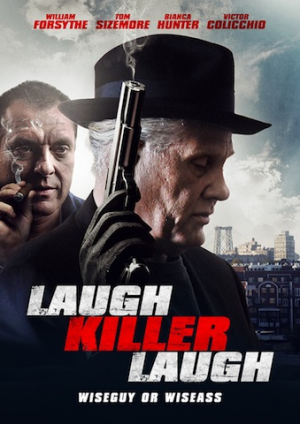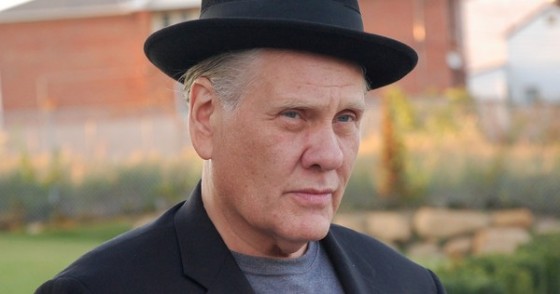You can’t blame Laugh Killer Laugh for reaching hard to come across as a gritty crime film in the vein of numerous East Coast crime movies, because the film achieves a kind of off-kilter genuineness that only certain B-movies can achieve. The film, in select theaters now, as well as on VOD and iTunes, has the exterior look of a low-budget Abel Ferrara crime thriller, but it fails in some areas when it tries to place its main character, a ruthless killer and hitman named Frank Stone (William Forsythe), within the confines of a nuanced character study. Despite its shortcomings, the film can be enjoyed by accepting its inherent strangeness.
Frank Stone works as a contract killer and jewel thief for low-level Italian mobsters in New York City, and his status as a social outcast is established by a generally blank affect that threatens to flatten Forsythe’s performance. A sinister voice inside his head in the form of a sexually abusive school headmaster (Tom Sizemore) from Frank’s childhood gives the only back story to the mostly silent Stone. Frank’s life changes near the middle of the film when he meets Jackie (Bianca Hunter), a woman who encourages him to take a creative writing course that she attends. Frank slowly discovers a new outlet for talking about his years as a hitman when he begins to tell his story through the written word. He and Jackie grow closer, and Frank learns that she’d had her daughter taken from her years earlier. When Frank’s mob associates learn that he’s using material from his life of crime for his stories that could possibly implicate them, they go after Jackie, kill her, and put Frank in a coma, from which he inexplicably emerges, somewhat unconvincingly and without a proper character arc, with a sunnier disposition and begins to, as the title tells us, laugh. He then goes on a rampage and kills the people responsible for Jackie’s death.
A summary of the film’s plot reads like the outline of most of the typical direct-to-video detritus currently languishing in all the grocery store Redbox vending machines across America, but the film’s strengths — of which it may have none for those seeking high-concept, big-budget action filmmaking — lie in Sizemore’s brooding performance, and in the use of local New York actors and crew members who give the film a very provincial, authentic feel.
Laugh Killer Laugh has the kind of nervous street energy that only exists in East Coast tough guy movies. The use of outer borough locations, with expressive lighting and shadows, may remind some viewers of darker-themed 1940s film noir, but in HD color. Think of what Edgar G. Ulmer was able to accomplish with light and shadows on a limited budget in his landmark noir, Detour, and the viewer may be able to appreciate what writer/director Kamal Ahmed and cinematographer Tom Agnello have achieved visually. A special nod must be given to Bianca Hunter, who also played one of the bridge-and-tunnel girls that Harvey Keitel verbally assaulted in one infamous scene in Abel Ferrara’s 1992 crime masterpiece Bad Lieutenant. Her character Jackie, who falls in love with Frank before she’s killed by his mob friends, gives the movie a certain amount of heart that counters the film’s callous violence and Forsythe’s mean-mugging.
Another odd fact about Laugh Killer Laugh is that director Ahmed is one half of ‘90s comedy duo The Jerky Boys. Several jokes in his script work surprisingly well in the film, showing that Ahmed can still be funny. Ahmed, a native New Yorker, captures the energy, cadences, and some of the mordant humor of his hometown quite well, which contribute to his film’s peculiar look and authenticity. Laugh Killer Laugh transcends its badness by being unapologetically, unpretentiously, itself.









Comments on this entry are closed.